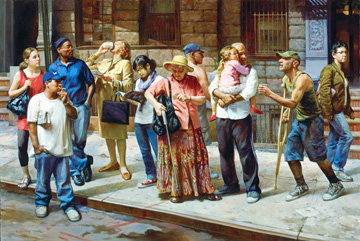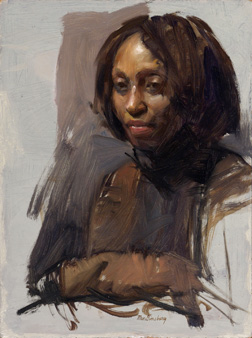Art Critique:
Max Ginsburg at the Salmagundi Club, NYC
By Raymond J. Steiner
ART TIMES Sept/ Oct 2011
 Bus Stop Bus Stop |
JUST WHEN I begin to despair about the waning quality of American art, along comes The Salmagundi Club to raise me out of my doldrums and lighten my spirits with a spectacular retrospective showing of Max Ginsburg’s paintings*. Sixty-plus works — early as well as late, illustrations as well as paintings — comprise the show and one would be hard-pressed to find a single work unworthy of Ginsburg’s masterful skill at classical representation. To be sure, the Salmagundi has a long history of exhibiting world-class art, but Ginsburg’s work is something a bit special. Nor does the Salmagundi often give over their walls to a single artist, but they certainly have an eye for exceptionally outstanding artists when they find them. To say that Max Ginsburg is a “realist” is somewhat misleading — for he is that, and then some. His figurative work ranges from early “impressions” through the sketchy use of a palette knife (“My Father”), to such graphic depictions as “Torture Abu Grahaib” — with a subtle range of nuance lying in-between. And, although he can depict the majesty of a human countenance with no intervening ‘social comment’ — “Caretakers”, for example, or “Theresa Study” — mostly he chooses to depict them in extremities — “War Pieta”, “The Beggar”, “Blind Beggar”.
 Foreclosure Foreclosure |
His images have an almost blinding clarity, a “thereness” that fairly overwhelms the viewer. Whether it be a single visage or a throng of humanity captured en masse, Ginsburg penetrates into the very essence of his subject matter — what the Germans refer to as the ding an sich, the very ur-ground of a thing — to turn it “inside-out”, so to speak, so that there can be no mistaking his vision or intent. It is to a Ginsburg painting — say, “Foreclosure” — that the expression “one picture is worth a thousand words” truly fits. And yet, here I am, trying to put words down, one after the other, to bring you some idea of what it is to actually view one of his paintings. A humanist with a social realist message, Ginsburg makes perfectly clear what his ‘message’ is — and that is that the human condition is at times a sorry thing to behold. I say “social realist” since, if I had to catalog his work, his work most properly fits that ‘30s theme in American art. Neither as sarcastic, say, as a Jack Levine, Ginsburg still goes beyond the somewhat ‘softer’ humanism of a Philip Reisman — (both artists, incidentally, that I’d profiled and come to know personally during their lifetimes) and whom Ginsburg (whom I’ve not met) most reminds me. Although “Torture Abu Grahaib” is a notable exception, Ginsburg’s focus seems to be less on the individual — victim or perpetrator — than on the misfortunes inflicted upon humankind. War, poverty, illness, aging — these are the culprits in Ginsburg’s eyes, conditions of humanity that ought to be addressed — if out of our power to ameliorate. We can — declares Ginsburg’s paintings — at the very least take notice and sympathize, empathize. He does this by what I term above his ‘blinding clarity’. Thus, when I say that he does not focus on the individual but on the ‘problem’, this does not mean that he slights his duties in depicting that human — Ginsburg is nothing if not a highly-skilled draftsman.
 Theresa |
Facial and bodily details — of age, of race, of gender — are exquisitely rendered, carefully delineated by an eye and hand that is very nearly infallible. Undoubtedly, it his role as illustrator (several included in this exhibit — “Tapestry”, Hoops”, “Another Time, Another Village”, etc.) — that honed his talents of verisimilitude, but Ginsburg’s precision goes far beyond the human face. Automobiles, park benches, building facades, crutches, food stands, clothing, fences, fire escapes, gates, canes, stone steps and walls — all are given equal care, equal time of his attention and skill. Note, for just one example, the chain-link fence in “Two Worlds” and its shadow on the back of a person seated nearby. Look closer: Now see how the individual links of the actual fence are merely “commas” of white paint — as we step back from the painting, the illusion is magically masterful. In his artist’s statement, Ginsburg states: “I believe realism is truth and truth is beauty” — in viewing his work, one can hardy argue with his reasoning.
*“Max Ginsburg Retrospective Exhibition” (thru Aug 5), The Salmagundi Club, 47 Fifth Ave., NYC (212) 255-7740. The show will travel to The Butler Institute of American Art, 524 Wick Avenue, Youngstown, Ohio (Sept. 15 - Nov. 11, 2011). For more images and information about Max Ginsburg see: maxginsburg.com
